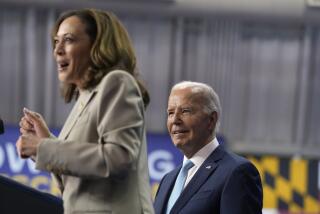Beefs Abound Over Possible Meat Industry Deal
- Share via
Squeals of protest erupted last week from farmers, politicians and regulators when Smithfield Foods Inc. offered to buy its largest competitor and the nation’s biggest beef processor, IBP Inc., for $2.7 billion in stock, besting a deal put together by management and a Wall Street investment group.
The combination of these two meat behemoths would give one company control of almost 40% of the nation’s pork and beef packing businesses--enough market power, they say, to depress prices paid to farmers, muscle out smaller competitors and eventually drive up prices at supermarket checkout stands.
Smithfield executives argue that it would just put them on par with the poultry industry, which is just as concentrated and, they contend, still intensely competitive.
Smithfield Chairman and Chief Executive Joseph W. Luter III said an acquisition of this size is necessary to gain the leverage the company needs to deal with the handful of major supermarket chains such as Kroger, Safeway and Albertson’s that have been swallowing up their regional rivals.
And it’s critical, he said, to Smithfield’s plan to follow poultry giants such as Tyson Foods Inc. in turning a low-margin commodity business into a more profitable national brand sold in its own packages.
But for some Midwestern farmers, the marriage could prove costly.
Unless the company is forced by regulators to divest plants, some producers would have only one customer for their hogs. And they could have little choice but to become contract farmers for a vertically integrated Smithfield, rather than sell their hogs on the open market.
“This raises a lot of concerns in terms of market power and ownership,” Agriculture Secretary Dan Glickman said. ‘You have to wonder what its effect will be on independent farmers.”
In recent years, American Farm Bureau Federation officials say, nearly a third of this country’s hog producers have left the business. They fear this purchase could “accelerate that trend.”
The farm bureau, Glickman and lawmakers have asked the Justice Department to carefully review the acquisition. Separately, Iowa Atty. Gen. Tom Miller has announced plans to investigate the proposed deal.
“The influence that could be exerted over several segments of the industry rather than just one is particularly unsettling to agricultural producers,” said Bob Stallman, farm bureau president.
In a conference call with investors, Luter said he is confident the merger would pass regulatory scrutiny, although he believes it could entail the sale of a plant or two to ensure competition in the Midwest. On the same call, he also said the company’s plans could include expanding into commodities such as turkey or other poultry.
Indeed, Smithfield has grown more quickly than the hogs fattening on its farms in recent years. Its acquisition this year of Murphy Family Farms, the nation’s second-largest hog producer, drew criticism and review by the Justice Department, as it followed by less than a year an acquisition of giant hog producer Carroll’s Foods.
In less than three years, the company has moved from being the country’s seventh-largest hog producer to being No. 1, with sales of $5.2 billion in its last fiscal year.
And it has expanded its processing business, buying Schneider, Canada’s largest processor, North Side Foods, which makes sausage patties for McDonald’s, and purchased a huge Iowa plant from cooperative Farmland Industries.
But it’s the company’s push to vertical integration--controlling the entire production chain from farm to fork--that has drawn the most criticism.
Attorneys general in several Midwestern states have accused the company of trying to skirt laws there that discourage packers from owning their own hogs.
If packers have their own supply of hogs, politicians say, who are farmers going to sell to? The flood of big agribusiness mergers in recent years, from grain, seed and tractor companies to meat processors, has sparked outrage from farm groups, politicians and regulators who claim it is squeezing the family farm from both sides, ending price competition and upping the pressure for farmers and independent packers to get out or sell out.
Four companies now control 80% of the beef slaughter business and the top four pork processors control 50% of that business.
Thus far, economists say, there’s been no evidence that these increasingly powerful players in the food industry have been able to wring higher prices out of consumers. But there’s no question, they say, that farmers have gotten squeezed.
The hog farmers’ share of the retail price per pound dropped to 25% last year from 35% in 1994, according to the Department of Agriculture, as the share of wholesalers such as Smithfield edged up slightly from 14% to 16%
Yet the struggle has been largely invisible to consumers. Even as hog prices plummeted between 1998 and 1999, the even larger retail markup charged by supermarkets has kept retail prices relatively unchanged.
“The retailer makes a higher margin than we do,” Jerry Hostetter, a Smithfield vice president, said.
Smithfield hopes to boost its profits even further by selling its own branded products such as Smithfield’s Lean Generation Pork and persuading supermarkets and other retailers to shed their butcher departments and let them supply them with packaged cuts of meat, albeit for a slightly higher price.
“We see the pork industry going the way of the poultry business, becoming vertically integrated,” Hostetter said.
This vertical integration and the relatively few players controlling the food chain are what concern economists. More is at stake here than the family farm, they say.
Consolidation could not only drive up retail prices, they say, it could put food safety at risk, as more animals zoom down assembly lines, and endanger the environment.
Already, several states have moved to block huge farms. North Carolina has put a moratorium on new corporate hog farms after waste fouled rivers and enteredChesapeake Bay.
In 1996, the Environmental Protection Agency fined Smithfield $12.6 million after its processing plants in Virginia violated the Clean Water Act by discharging pollutants into the Pagan River.
And earlier this year, the Justice Department, on behalf of the EPA, sued IBP alleging that the meatpacker was violating numerous environmental laws at its slaughter plant in Dakota City, Neb.
A number of legal challenges also have been filed by producers and the USDA’s Grain Inspection, Packers and Stockyards Administration, which monitors the industry for unfair competition along with the Federal Trade Commission, which monitors the retail trade of meat.
But, Glickman said, predatory pricing practices have been hard to prove, especially as the industry has shifted to a system of independent contracts, rather than open-market sales.
Although federal law requires mandatory price reporting, in many states there are laws that allow for confidential provisions in contracts, clauses that could drive prices up or down.
In Marcus, Iowa, where Alan Hoefling raises about 5,000 hogs a year, he estimated that as up to 70% to 80% of his neighboring farmers are signing advance price contracts for their hogs, rather than selling hogs for that day’s cash price.
Contracts, he said, have put a damper on the daily average used to calculate his price, and he contended that they continue to spiral lower as farmers get more dependent on them.
“Every time a contract expires, the news gets less and less good for the producer,” he said.
Hoefling is lucky. He’s found a niche selling his extra-marbled pork to a packer with export clients looking for juicier cuts. But, he added, if he wanted to expand his farm, bankers would demand some kind of additional security in the form of a contract arrangement with a big packer.
Not everyone is opposed to vertical integration and private contracting. There are some who say it is inevitable as the country has become industrialized. Bigger processors can serve more markets around the world, for example, which could expand farmers’ prospects.
Indeed, some economists and industry observers have even compared contract farming to the system in which fast-food franchisees buy supplies and produce food to meet the specifications of a certain company.
“What some farmers are electing to do is join the supply chain,” said Alan Barkema, an economist with the Federal Reserve Bank of Kansas City. “They can shed or share the market risk or product risk.” And, he said, in a low-margin business with few barriers to entry, it’s a way for some to hold on to their farms.
Meanwhile, regulators are restructuring their own ranks and reviewing federal policy to make sure they have the power to crack down on abuses.
The USDA is organizing teams of attorneys and economists to study predatory pricing practices, and the Justice Department has appointed a special counsel to help it monitor anti-competitive issues in the agricultural sector.
But, Glickman said, new legislation probably will be needed to ensure the fairness and transparency of agricultural price contracts, perhaps a “lemon law” for producers.
And Hoefling said tougher watchdogs are needed to protect consumers, who have seen concentration raise prices of other staples such as gasoline.
“When you have four big companies that are going to run the food chain in this country, they’re going to have a cartel just like OPEC does,” Hoefling said. “They’re going to be able to cut back on the beef herd or cut back on hogs and create a shortage [that drives up prices]. That’s what the consumer has to lose.”
(BEGIN TEXT OF INFOBOX / INFOGRAPHIC)
Hogging the Profits?
Although prices paid to farmers for their hogs have been declining over the last three years, retail prices have held steady. Retailers pocket most of the markup.
*--*
Average Average Average retail price* wholesale price* paid to farmers* 1994 $2.10 $1.04 $ 0.78 1995 2.06 1.04 0.83 1996 2.34 1.23 1.06 1997 2.45 1.23 1.02 1998 2.43 0.97 0.65 1999 2.42 0.99 0.64
*--*
* Price per pound
Source: U.S. Department of Agriculture
More to Read
Inside the business of entertainment
The Wide Shot brings you news, analysis and insights on everything from streaming wars to production — and what it all means for the future.
You may occasionally receive promotional content from the Los Angeles Times.










